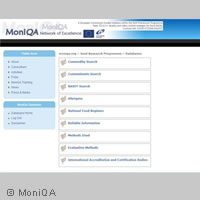MONIQA tackles food quality and safety with innovative result
How safe is the food we eat? While many have been stumped by this question, the EU-funded MONIQA ('Monitoring and quality assurance in the total food supply chain') project has responded with the development of reliable tools and methods to assess the foods we consume. The project, backed with over EUR 12 million under the 'Food quality and safety' Thematic area of the EU's Sixth Framework Programme (FP6), offers a database of food quality and safety issues, as well as analytical tools for food production and the supply chain. The MONIQA consortium, made up of 33 organisations from Europe and abroad, focused on harmonising global food quality and safety monitoring and control strategies. Thanks to this state-of-the-art database, users gain access to legislative restrictions and corresponding analytical and sampling methods. The MONIQA partners say one of the database's fundamental components is the EU Rapid Alert System (RASFF), a pivotal tool in the EU's drive to guarantee food safety by enabling a fast yet effective exchange of information between Member States and the European Commission when risks to human health are detected in the food and feed chain. The database comprises comprehensive lists of contaminants and commodities in which these contaminants may pose a food-chain threat. These lists are linked with the data sources. The partners explain that RASFF data was first used to establish the basic structure of the database; more data has since been added with results from MONIQA. These results include methods currently used by the MONIQA partners to identify and quantify hazards and/or contaminants, information on national food regimes and a report archive, as well as report-based information on food quality and safety challenges. Thanks to the project partners, RASFF data has already been converted into a database that is 100% searchable and relational. Users can look for RASFF notifications by commodity, contaminant, country of origin and/or reporting countries. The partners say broad groupings of contaminants covered by the RASFF were used to establish the contaminant categories in the database, as were groupings where EU legislation governing maximum permissible levels in food or feed exists. The commodities list was first based on legislation governing pesticide maximum residue levels, but was later extended to include specific fruits or vegetables where contaminant legislation specifically exists or which regularly crop up in the RASFF. Finally, animal products and key corresponding legislation were included in the database as well. Individuals interesting in obtaining more information can download the 'MONIQA Methods Database in Seven Easy Steps' document from the project website. In another development, the second international MONIQA conference was held in Krakow, Poland on 8 to 10 June where participants formed a multidisciplinary bridge between the concerns of food and nutrition science and the socioeconomic impact of food hazards. The conference members placed emphasis on advancements made in food safety standards, mycotoxins and phycotoxins, food allergens, chemical contaminants, food additives, microbiological contamination, and emerging technologies for food safety assessment and food authenticity. Kicked off in 2007 and due to end in 2012, MONIQA is coordinated by the International Association for Cereal Science and Technology in Austria, and brings together key research and industry experts from Europe, Asia and Oceania.
Countries
Austria, Poland



